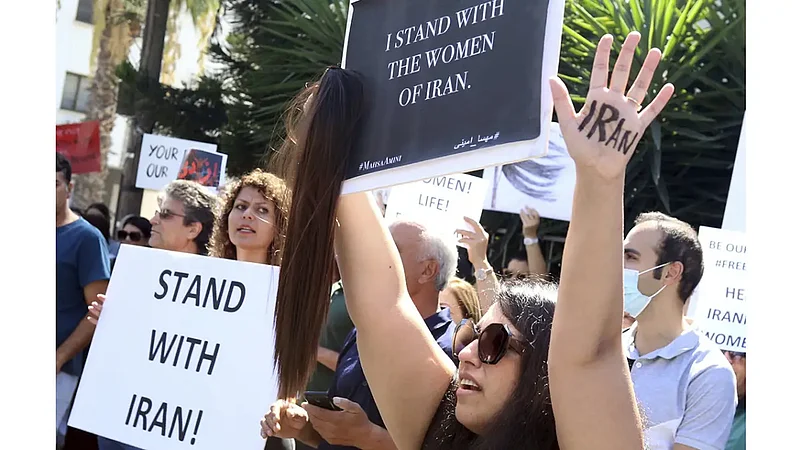Iran's Supreme Leader Ayatollah Ali Khamenei on Monday termed the nationwide protests as "rioting" and blamed them on the United States and Israel.
For several days, Iran has been rocked with nationwide protests over the death of 22-year-old Mahsa Amini in the custody of Iran's morality police. Amini was detained for violating Iran's hijab rules and was allegedly beaten in policy, following which she died in a hospital.
While Khamenei expressed sorrow at Amini's death, he did not have any soft corner for the protesters, who he called foreign-sponsored. He also called the act of women tearing their hijabs in public —a signature protest move defying Iran's hijab mandate— as abnormal and unnatural.
Khamenei said he was "heartbroken" by Amini's death but sharply condemned the protests as a foreign plot to destabilise Iran, echoing authorities' previous comments.
He said, "This rioting was planned. These riots and insecurities were designed by America and the Zionist regime, and their employees."
Khamenei described scenes of protestors ripping off their state-mandated hijabs —head coverings— and setting fire to mosques, banks and police cars as "not normal" and "unnatural".
Mahsa Amini's death, Iran's hijab rules
Mahsa Amini, 22, was out with her brother when she was detained by Iran's morality police for not properly covering her head with hijab.
Amini was detained and allegedly beaten in the custody. She later died in a hospital.
Iran requires women to cover their heads with hijab in public. They are also mandated to wear loose clothing that neither shows skin nor is too tight and revealing of form. There are also restrictions of mingling of men and women in public. Such restrictions are in place since the Islamic Revolution of Iran in 1979 when liberal monarchy was overthrown and power was captured by ultra-conservative Islamic clergy. The morality police is in charge of enforcing hijab rules.
"Officers [of morality police] have the power to stop women and assess whether they are showing too much hair; their trousers and overcoats are too short or close-fitting; or they are wearing too much make-up. Punishments for violating the rules include a fine, prison or flogging," reports BBC.
The 1979 Islamic Revolution of Iran marked a sharp reversal of women's lifestyle in Iran. Prior to the Revolution, women in at least urban parts of the country were free to dress as per their will, with photographs from the period of women in skirts and swimsuits available on the internet.
Protests across Iran, defiance by women
In weeks since Amini's death, several thousands of people have taken to the threats to hold protests against the Iranian regime.
Women have publicly cut their hair and have burnt their hijab in protest and in defiance of Iran's rulers and their rules. Several women have also ditched their hijab in public while going about their everyday lives, defying the Iranian state but also earning the ire of the Iranian regime.
Khamenei comments come as nationwide protests sparked by Amini's death entered a third week despite the government's efforts to crack down.
Iran's state TV has reported the death toll from violent clashes between protesters and the security officers could be as high as 41, without providing details. Rights groups have given higher death tallies, with London-based Amnesty International saying it has identified 52 victims, including five women and at least five children.
One woman, said to be named Hadis Najafi, who became a symbol of women's resistance and defiance with a clip of hers tying her hair and then joining street protests, was killed shortly after she was videographed.
An untold number of people have been apprehended, with local officials reporting at least 1,500 arrests. Authorities have repeatedly blamed foreign countries and exiled opposition groups for fanning the unrest, without providing evidence.
Simmering anger coming to the fore
A large number of men have also joined the women in protesting against the Iranian regime.
While Amini's daeth is the immediate trigger, simmering anger over the battered economy and longtime curbs on civil liberties has also come to the fore in the current protests. The protests over Amini's death have also tapped into a deep well of grievances in Iran, including the country's surging prices, high unemployment, social restrictions and political repression.
Demonstrations have continued in Tehran and far-flung provinces even as authorities have restricted internet access to the outside world and blocked social media apps.
As the new academic year began this week, students gathered in protest at universities across Iran, according to videos widely shared on social media, chanting slogans against the government and denouncing security forces' clampdown on demonstrators.
Universities in major cities including Isfahan in central Iran, Mashhad in the northeast and Kermanshah in the west have held protests featuring crowds of students clapping, chanting and burning state-mandated headscarves.
“Don't call it a protest, it's a revolution now,” shouted students at Shahid Beheshti University in the capital of Tehran, as women took off their hijabs and set them alight, in protest over Iran's law requiring women to cover their hair.
“Students are awake, they hate the leadership!” chanted crowds of students at the University of Mazandaran in the country's north.
(With AP inputs)
















